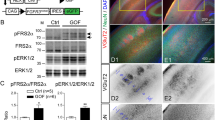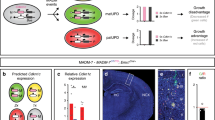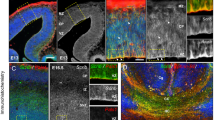Abstract
The molecular mechanisms that activate morphogenesis of cerebral cortex are currently the subject of intensive experimental analysis. Transcription factor genes of the homeobox, basic helix-loop-helix (bHLH) and zinc-finger families have recently been shown to have essential roles in this process. However, the actual selector genes activating corticogenesis have not yet been identified. Here we show that high-level expression of at least one functional allele of either of the homeobox genes Emx2 or Pax6 in the dorsal telencephalon is necessary and sufficient to stably activate morphogenesis of cerebral cortex and to repress that of adjacent structures, such as striatum.
This is a preview of subscription content, access via your institution
Access options
Subscribe to this journal
Receive 12 print issues and online access
$209.00 per year
only $17.42 per issue
Buy this article
- Purchase on Springer Link
- Instant access to full article PDF
Prices may be subject to local taxes which are calculated during checkout








Similar content being viewed by others
Change history
07 February 2012
In the version of this article initially published, author Barbara Di Benedetto's name was misspelled. The error has been corrected in the HTML and PDF versions of the article.
References
Bulchand, S., Grove, E.A., Porter, F.D. & Tole, S. LIM-homeodomain gene Lhx2 regulates the formation of the cortical hem. Mech. Dev. 100, 165–175 (2001).
Monuki, E.S., Porter, F.D. & Walsh, C.A. Patterning of the dorsal telencephalon and cerebral cortex by a roof plate–Lhx2 pathway. Neuron 32, 591–604 (2001).
Toresson, H., Potter, S.S. & Campbell, K. Genetic control of dorsal-ventral identity in the telencephalon: opposing roles for Pax6 and Gsh2. Development 127, 4361–4371 (2000).
Yun, K, Potter, S. & Rubenstein, J.L.R. Gsh2 and Pax6 play complementary roles in dorsoventral patterning of the mammalian telencephalon. Development 126, 193–205 (2000).
Fode, C. et al. A role for neural determination genes in specifying dorsoventral identity of telencephalic neurons. Genes Dev. 14, 67–80 (2000).
Theil, T., Alvarez-Bolado, G., Walter, A. & Rüther, U. Gli3 is required for Emx gene expression during dorsal telencephalon development. Development 126, 3561–3571 (1999).
Tole, S., Ragsdale, C.W. and Grove, E.A. Dorsoventral patterning of the telencephalon is disrupted in the mouse mutant extra-toes J. Dev. Biol. 217, 254–265 (2000).
Walther, C. & Gruss, P. Pax-6, a murine paired box gene, is expressed in the developing CNS. Development 113, 1435–1449 (1991).
Mallamaci, A. et al. EMX2 in the developing mouse brain and in the olfactory area. Mech. Dev. 77, 165–172 (1998).
Goetz, M., Stoykova, A. & Gruss, P. Pax6 controls radial glia differentiation in the cerebral cortex. Neuron 21, 1031–1044 (1998).
Mallamaci, A., Muzio, L., Chan, C.H., Parnavelas, J. & Boncinelli, E. Area identity shifts in the early cerebral cortex of Emx2−/− mutant mice. Nat. Neurosci. 3, 679–686 (2000).
Warren, N. et al. The transcription factor, Pax6, is required for cell proliferation and differentiation in the developing cortex. Cereb. Cortex 9, 627–635 (1999).
Mallamaci, A. et al. The lack of Emx2 causes absence of Cajal-Retzius cells and reeler-like defects of neuronal migration in the developing cerebral cortex. J. Neurosci. 20, 1109–1118 (2000).
Caric, D., Gooday, D., Hill, R.E., McConnell, S.K. & Price, D.J. Determination of the migratory capacity of embryonic cortical cells lacking the transcription factor Pax6. Development 124, 5087–5096 (1997).
Tarabykin, V., Stoykova, A., Usman, N. & Gruss, P. Cortical upper layer neurons derive from the subventricular zone as indicated by Svet1 gene expression. Development 128, 1983–1993 (2001).
Bishop, K.M., Goudreau, G. & O'Leary, D.D. Regulation of area identity in mammalian neocortex by Emx2 and Pax6. Science 288, 344–349 (2000).
Muzio, L. et al. Emx2 and Pax6 control regionalisation of the pre-neuronogenic cortical primordium. Cereb. Cortex 12, 129–139 (2002).
Pellegrini, M., Mansouri, A., Simeone, A., Boncinelli, E. & Gruss, P. Dentate gyrus formation requires Emx2. Development 122, 3893–3898 (1996).
Yoshida, M. et al. Emx1 and Emx2 functions in development of dorsal telencephalon. Development 124, 101–111 (1997).
Tole, S., Goudreau, G., Assimacopoulos, S. & Grove, E.A. . Emx2 is required for growth of the hippocampus but not for hippocampal field specification. J. Neurosci. 20, 2618–2625 (2000).
Stoykova, A., Treichel, D., Hallonet, M. & Gruss, P. Pax6 modulates the dorsoventral patterning of the mammalian telencephalon. J. Neurosci. 20, 8042–8050 (2000).
Hill, R.E. et al. Mouse small eye results from mutations in a paired-like homeobox containing gene. Nature 354, 522–525 (1991).
Bulfone, A. et al. Expression pattern of the Tbr2 (Eomesodermin) gene during mouse and chick brain development. Mech. Dev. 84, 133–138 (1999).
Briata, P. et al. EMX1 homeoprotein is expressed in cell nuclei of the developing cerebral cortex and in the axons of the olfactory sensory neurons. Mech. Dev. 57, 169–180 (1996).
Hallonet, M. et al. Vax1 is a novel homeobox-containing gene expressed in the developing anterior ventral forebrain. Development 125, 2599–2610 (1998).
Ericsson, J. et al. Sonic Hedgehog induces the differentiation of ventral forebrain neurons: a common signal for ventral patterning within the neural tube. Cell 81, 747–756 (1995).
Corbin, J.G., Gaiano, N., Machold, R.P., Langston, L. & Fishell, G. The Gsh2 homeodomain gene controls multiple aspects of telencephalic development. Development 127, 5007–5020 (2000).
Kohtz, J.D., Baker, D.P., Corte, G. & Fishell, G. Regionalization within the mammalian telencephalon is mediated by changes in responsiveness to Sonic Hedgehog. Development 125, 5079–5089 (1998).
Frantz, G.D., Weimann, J.M., Levin, M.E. & McConnell, S.K. Otx1 and Otx2 define layers and regions in the developing cerebral cortex and cerebellum. J. Neurosci. 14, 5725–5740 (1994).
Grove, E.A., Tole, S., Limon, J., Yip, L.W. & Ragsdale, C.W. The hem of the embryonic cerebral cortex is defined by the expression of multiple Wnt genes and is compromised in Gli3-deficient mice. Development 125, 2315–2325 (1998).
Dou, C.L., Li, S. & Lai, E. Dual role of Brain factor-1 in regulating growth and patterning of the cerebral hemispheres. Cereb. Cortex 9, 543–550 (1999).
Lee, S.M.K., Tole, S., Grove, E.A. & McMahon, A.P. A local Wnt-3a signal is required for development of the mammalian hippocampus. Development 127, 457–467 (2000).
Lavdas, A.A., Grigoriou, M., Pachnis, V. & Parnavelas, J.G. The medial ganglionic eminence gives rise to a population of early neurons in the developing cerebral cortex. J. Neurosci. 99, 7881–7888 (1999).
Marin, O., Anderson, S. & Rubenstein, J.L.R. Origin and molecular specification of striatal interneurons. J. Neurosci. 20, 6063–6076 (2000).
Marin, O., Yaron, A., Bagri, A., Tessier-Lavigne, M. & Rubenstein, J.L.R. Sorting of striatal and cortical interneurons regulated by semaphorin-neuropilin interactions. Science 293, 872–875 (2001).
Takahashi, T., Nowakowski, R.S. & Caviness, V.S. Jr. Interkinetic and migratory behaviour of a cohort of neocortical neurons arising in the early embryonic murine cerebral wall. J. Neurosci. 16, 5762–5776 (1996).
Wichterle, H., Garcia-Verdugo, J.M., Herrera, D.G. & Alvarez-Buylla, A. Young neurons from medial ganglionic eminence disperse in adult and embryonic brain. Nat. Neurosci. 2, 461–466 (1999).
Wichterle, H., Turnbull, D.H., Nery, S., Fishell, G. & Alvarez-Buylla, A. In utero fate mapping reveals distinct migratory pathways and fates in neurons born in the mammalian basal forebrain. Development 128, 3759–3771 (2001).
Hall, P.A. & Woods, A.L. Immunohistochemical markers of cellular proliferation: achievements, problems and prospects. Cell Tissue Kinet. 23, 505–522 (1990).
Ajiro, K., Yoda, K., Utsumi, K. & Nishikawa, Y. Alteration of cell cycle-dependent histone phosphorylations by okadaic acid. Induction of mitosis-specific H3 phosphorylation and chromatin condensation in mammalian interphase cells. J. Biol. Chem. 271, 13197–13201 (1996).
Thornberry, N.A. & Lazebnik, Y. Caspases: enemies within. Science 281, 1312–1316 (1998).
Shimamura, K. & Rubenstein, J.L. Inductive interactions direct early regionalization of the mouse forebrain. Development 124, 2709–2718 (1997).
Furuta, Y., Piston, D.W. & Hogan, B.L.H. . Bone morphogenetic proteins (BMPs) as regulators of dorsal forebrain development. Devlopment 124, 2203–2212 (1997).
Chiang, C. et al. Cyclopia and defective axial patterning in mice lacking Sonic Hedgehog gene function. Nature 383, 407–413 (1996).
Sussel, L., Marin, O., Kimura, S. & Rubenstein, J.L.R. Loss of Nkx2.1 homeobox gene function results in a ventral to dorsal molecular respecification within the basal telencephalon: evidence for a transformation of the pallidum into the striatum. Development 126, 3359–3370 (1999).
Chapouton, P., Gaertner, A. & Goetz, M. . The role of Pax6 in restricting cell migration between developing cortex and basal ganglia. Development 126, 5569–5579 (1999).
Inoue, T. et al. Role of cadherins in maintaining the compartment boundary between the cortex and the striatum during development. Development 128, 561–569 (2001).
Stoykova, A., Goetz, M., Gruss, P. & Price, J. Pax6-dependent regulation of adhesive patterning, R-cadherin expression and boundary formation in the developing forebrain. Development 124, 3765–3777 (1997).
Mallamaci, A., Di Blas, E., Briata, P., Boncinelli, E. & Corte, G. OTX2 homeoprotein in the developing central nervous system and migratory cells of the olfactory area. Mech. Dev. 58, 165–178 (1996).
Simeone, A. et al. A vertebrate gene related to orthodenticle contains a homeodomain of the bicoid class and demrcates anterior neuroectoderm in the gastrulating mouse embryo. EMBO J. 12, 2735–2747 (1993).
Acknowledgements
We thank J. Parnavelas, P. Bovolenta and A. Bulfone for critical reading of the manuscript. This work was funded by the EU (QLG3-CT-2000-00158; QLG3-CT-2000-01625; HPRN-CT-2000-00097), the Italian Ministery of Health (CS030.5/RF00.73), the Italian National Research Council (PF01.00026.PF49) and the University Excellence Center on Physiopathology of Cell.
Author information
Authors and Affiliations
Corresponding author
Ethics declarations
Competing interests
The authors declare no competing financial interests.
Rights and permissions
About this article
Cite this article
Muzio, L., Di Benedetto, B., Stoykova, A. et al. Conversion of cerebral cortex into basal ganglia in Emx2−/− Pax6Sey/Sey double-mutant mice. Nat Neurosci 5, 737–745 (2002). https://doi.org/10.1038/nn892
Received:
Accepted:
Published:
Issue Date:
DOI: https://doi.org/10.1038/nn892
This article is cited by
-
Subtype Specification of Cerebral Cortical Neurons in Their Immature Stages
Neurochemical Research (2018)
-
Molecular logic of neocortical projection neuron specification, development and diversity
Nature Reviews Neuroscience (2013)
-
Erratum: Corrigendum: Conversion of cerebral cortex into basal ganglia in Emx2−/− Pax6Sey/Sey double-mutant mice
Nature Neuroscience (2013)
-
Neurog1 and Neurog2 coordinately regulate development of the olfactory system
Neural Development (2012)
-
MiR-30e and miR-181d control Radial Glia cell proliferation via HtrA1 modulation
Cell Death & Disease (2012)



